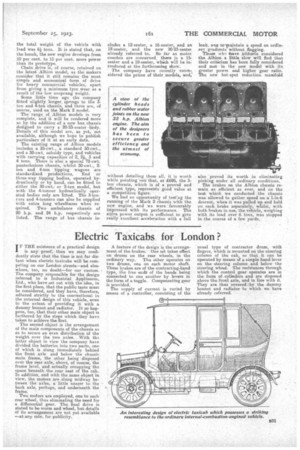Electric Taxicabs for London ?
Page 15

If you've noticed an error in this article please click here to report it so we can fix it.
F THE existence of a practical design
is any proof; then we may confidently state that the time is not far distant when electric taxicabs will be competing on our London streets—and elsewhere, too, no doubt—for our custom. • The company responsible for the design referred to is Industrial Appliances, Ltd., who have set out with the idea in the first place, that the public taste must be considered, and they have, therefore, adhered strictly to the conventional in the external design of this vehicle, even to the extent of providing it with a dummy bonnet and radiator. It so happens, too, thattheir other main object is furthered by the steps which they have taken to achieve the first.
The second object is the arrangement of the main components of the chassis so as to secure an even distribution of the weight over the two axles. With the latter object in view the company have divided the batteries into two parts, one of which is slung immediately behind the front .axle and below the chassis main frame, the other being 'disposed over the rear axle, above, of course, the frame level, and actually occupying the space beneath the rear seat of the cab. In addition, and with the same object in view, the Motors are slung midway between the aides, a. little nearer to the hack axle, perhaps, and underneath the '
frame. • .
Two motors are employed, one to each rear wheel, thus eliminating the need for
a differential gear. The final drive is stated to be worm and wheel, but details of its arrangement are not yet available —at any rate, for publicity.
A feature of the design is the arrangement of the brakes. One set takes effect on drums on the rear wheels, in the ordinary way. Tho other operates on two drums, one on each motor shaft. These brakes are of the contracting-band type, the free end§ of the bands being connected to one another by levers in the form of a toggle. Compensating gear is provided.
The supply of current is varied by means of a controller, consisting of the usual type of contractor drum, with fingers, which is mounted on the steering column of the cab, so that it can be operated by means of a simple hand lever on thesteering column and below the steering wheel. The resistances through which the control gear operates are in -the form of cylinders and are disposed above the front axle, and in line with it. They are thus covered !lay the dummy bonnet and radiator to which we have already referred.






























